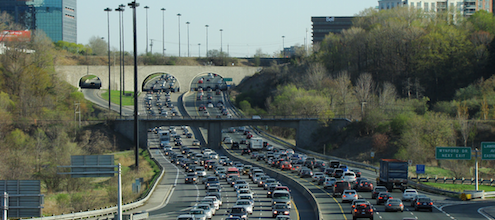
Congestion pricing can incentivize drivers to reduce traffic
Canadians know that traffic congestion is terrible and getting worse every year. We also know that governments spend a lot of our money on new transportation investments – but somehow the traffic jams keep getting bigger. If we are to really clear up our clogged freeways, we need to consider new policies and “congestion pricing” needs to play a central role.
We all hate sitting in traffic, white-knuckling it on crowded freeways, worried about getting to work late or missing an important meeting. Worst of all, we hate how traffic keeps us from spending all-too-scarce time with our family.
This massive waste of time is only the most obvious and frustrating cost associated with traffic congestion. As trucks sit in traffic jams, idling away for hours as they traverse the country, the all-in delivery costs of the goods being transported increases, and this raises prices for all consumers. All those tailpipe emissions from the cars and trucks stuck in traffic also harm our health and environment. Just the health costs associated with traffic congestion have been estimated to be $7-billion a year in Canada.
The different solutions to traffic congestion
The problem of traffic congestion usually invites two different proposed solutions. The first is based on the idea that cars and roads are bad, and that we therefore need to reduce the use of cars, get drivers off the road and force them into other modes of transportation. “Just make life difficult for drivers and we’ll solve the problem,” goes the thinking.
Yet, this approach denies the centrality of mobility to our lives and to the vitality of our economy. We need to get around this vast country, for all kinds of personal and economic reasons, and we need to do so safely and efficiently. Better mobility should be a central objective of transportation policy, not something to be stifled.
The second approach sees the problem as too little capacity, and so we build new and bigger roads and public-transit infrastructure. We certainly benefit from these new investments, but experience from around the world shows clearly that they don’t actually reduce traffic congestion. The greater capacity reduces congestion briefly, but then it attracts new drivers onto the road; before too long, traffic congestion has returned to its initial level.
How can we reduce traffic congestion while increasing our overall mobility?
A new report released Monday by Canada’s Ecofiscal Commission argues that we need to consider new policies if we really want to beat traffic congestion.
The real problem is not that we have too many cars or drivers. The real problem is too many cars at a specific place and time. The Don Valley Parkway in Toronto and Deerfoot Trail in Calgary aren’t problems at 2 a.m. But drive on them at 7:30 a.m. or 5:30 p.m. and you’re in a very different world. Road space is essentially unlimited in the middle of the night, but it’s the scarcest commodity around during peak travel times.
Canadians generally have free access to their roads. And like any other commodity, free access leads to overuse and serious shortages. So the real solution to traffic congestion will involve addressing these underlying incentives.
Congestion pricing as an effective deterrent
Congestion pricing attaches a price to the use of key traffic “pinch points,” and in some cases, the price is adjusted as the flow of traffic changes. Once even a small price is placed on the use of a crowded freeway, most drivers are led to re-examine their incentives, their routes, their driving times and their alternatives.
Experience from those cities that have used congestion pricing shows that many people have some flexibility in their schedules, and when they adjust their choices accordingly, the amount of traffic congestion falls significantly. Those who have little or no flexibility on any given day end up paying a small fee – but in return, they get to their destination faster, with fewer accidents and with less anxiety.
The evidence also strongly shows that the public’s support for these policies increases significantly after a trial period reveals how much faster they get home to their children. For this reason, the Ecofiscal Commission recommends that Canada’s largest and most congested cities design pilot projects tailored to their own geography and traffic flows.
With the problem of road congestion getting nothing but worse, Canadians can cling to our traditional policies and remain stuck in traffic – or we can try out new policy approaches and get home faster and more safely. What would our kids say?
This piece was originally published in the Globe and Mail Report on Business on November 3, 2015.




Comments are closed.